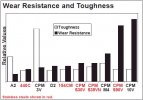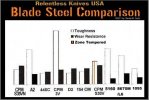- Joined
- Mar 1, 2014
- Messages
- 2
Hey guys, I'm new here. I just joined this forum, I've been reading and reading so many things about knives and steels and some really awesome comparisons, I really had to register here.
So, I would like to ask you something, I heard that the CPM 3V outperforms 1095 in everything for a survival or hard use knife.
I heard it's extremely tough, and has a LITTLE less wear resistance than CPM S30V (Got this from a graphic I found).
https://www.crucible.com/PDFs/\DataSheets2010\dsS30Vv1 2010.pdf
I also have read that it's not a stainless steel nor a High carbon steel, It's more like an hybrid, Beating 1095.
I don't know how sharp it can get.
Price it's not a factor for my comparison/question (I've heard that 1095 is a cheap but good steel when well H) I'm just talking about physical properties of these two types of steel.
So theorically, Is it true that the CPM 3V steel beats/outperforms 1095 in almost everything for a survival / hard use knife when BOTH steels are properly Heat Treated? (Would it be a good replacement/upgrade for a 1095 surival knife blade if money were not a problem?)
Thank you guys for your time!
So, I would like to ask you something, I heard that the CPM 3V outperforms 1095 in everything for a survival or hard use knife.
I heard it's extremely tough, and has a LITTLE less wear resistance than CPM S30V (Got this from a graphic I found).
https://www.crucible.com/PDFs/\DataSheets2010\dsS30Vv1 2010.pdf
I also have read that it's not a stainless steel nor a High carbon steel, It's more like an hybrid, Beating 1095.
I don't know how sharp it can get.
Price it's not a factor for my comparison/question (I've heard that 1095 is a cheap but good steel when well H) I'm just talking about physical properties of these two types of steel.
So theorically, Is it true that the CPM 3V steel beats/outperforms 1095 in almost everything for a survival / hard use knife when BOTH steels are properly Heat Treated? (Would it be a good replacement/upgrade for a 1095 surival knife blade if money were not a problem?)
Thank you guys for your time!


